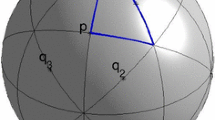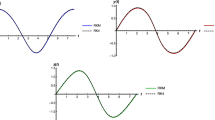Abstract
We deal with the spatial three-body problem in the various regimes where the Hamiltonian is split as the sum of two Keplerian systems plus a small perturbation. This is a region of the phase space \(T^{{\ast}}\mathbb{R}^{6}\) where the perturbation is small [3], the so called perturbing region \(\mathcal{P}_{\varepsilon,n}\). In particular, we prove the existence of quasi-periodic motions where the inner particles describe bounded near-rectilinear trajectories whereas the outer particle follows an orbit lying near the invariable plane. These motions fill in five-dimensional invariant tori. Moreover, the inner particles move in orbits either near an axis perpendicular to the invariable plane or near the invariable plane.
Access provided by Autonomous University of Puebla. Download conference paper PDF
Similar content being viewed by others
1 Introduction
We deal with the spatial three-body problem in the various regimes where the Hamiltonian is split as the sum of two Keplerian systems plus a small perturbation. This is a region of the phase space \(T^{{\ast}}\mathbb{R}^{6}\) where the perturbation is small [3], the so called perturbing region \(\mathcal{P}_{\varepsilon,n}\). In particular, we prove the existence of quasi-periodic motions where the inner particles describe bounded near-rectilinear trajectories whereas the outer particle follows an orbit lying near the invariable plane. These motions fill in five-dimensional invariant tori. Moreover, the inner particles move in orbits either near an axis perpendicular to the invariable plane or near the invariable plane.
By averaging over the mean anomalies, truncating higher-order terms and using singular reduction theory we get a one-degree-of-freedom Hamiltonian system defined in a singular reduced space, the so called orbit space. In [3] we analyse the relative equilibria and bifurcations and in [4] we reconstruct the invariant tori corresponding to motions of non-rectilinear type. Three of the relative equilibria of the reduced Hamiltonian in the orbit space are elliptic points corresponding to near-rectilinear motions of the inner bodies, and these are the ones we carry out the reconstruction of the KAM 5-tori surrounding them. We regularise the double inner collisions following the guidelines of Zhao [6, 7]. In particular, he applies the Kustaanheimo–Stiefel regularisation. This allows us to build sets of action-angle coordinates needed to apply KAM theory. The motions we deal with admit different combinations, for instance, the outer particle may move in a near-circular orbit or the invariable plane may coincide with the horizontal plane. This leads to various situations that have to be analysed in different intermediate reduced spaces. We achieve our study by considering all possible cases, constructing an adequate set of coordinates and computing the corresponding torsion in each case. Hence, our analysis is global and we characterise properly all type of bounded motions of the three particles (excluding triple collisions). In order to achieve the existence of the quasi-periodic motions we use a theorem by Han et al. [2] allowing us to handle the high-order degeneracy of the Hamiltonians involved in the process. The application of this theorem is not straightforward as one needs to bring the Hamiltonian to normal form through successive changes of symplectic coordinates and these transformations are rather cumbersome.
2 Reconstruction of the Full System
We reconstruct the rectilinear motions of the inner particles which are represented by elliptic relative equilibria of the reduced space, establishing the existence of KAM tori in the spatial 3-body problem. We characterise properly all type of bounded motions of the three particles, excluding triple collisions. In this sense our analysis, stated in Theorem 1, extends Zhao’s results [6]. The proof will appear in [5].
Deprit’s elements are used in Theorem 1. These coordinates were introduced by Deprit in [1] for eliminating two nodal angles in the N-body problem. In particular, ℓ 1 and ℓ 2 denote the mean anomalies of the inner and outer ellipses respectively, L i is the conjugate momentum to ℓ i (i = 1, 2) and C is the modulus of the total angular momentum vector.
Theorem 1
The Hamiltonian system of the spatial 3-body problem, reduced by the symmetry of translations and defined in \(\mathcal{Q}_{\varepsilon,n} \subseteq T^{{\ast}}\mathbb{R}^{6}\) (i.e., subset of \(\mathcal{P}_{\varepsilon,n}\) where resonances between the mean anomalies are avoided), has invariant KAM 5-tori densely filled with quasi-periodic trajectories of the fictitious inner and outer bodies of the following types:
-
(i)
The fictitious inner body moves in orbits nearly rectilinear, bounded and perpendicular to the invariable plane, whereas the outer body moves in a non-circular orbit lying near the invariable plane, and they are provided by \(L_{1}\not\approx \sqrt{3/10}C\).
-
(ii)
The fictitious inner body moves in orbits nearly rectilinear, bounded and perpendicular to the invariable plane, whereas the outer body moves in a near-circular orbit lying near the invariable plane, which is not the horizontal plane.
-
(iii)
The fictitious inner body moves in orbits nearly rectilinear, bounded and perpendicular to the invariable plane which is near the horizontal plane. The outer body moves in a near-circular orbit lying near the invariable plane, which is the horizontal plane.
-
(iv)
The fictitious inner body moves in orbits nearly rectilinear, bounded and lying near the invariable plane, whereas the outer body moves in a non-circular orbit that lies near the invariable plane.
For a given constant 0 < δ < 1∕5, the excluding measure for the existence of invariant 5-tori is of order \(\mathcal{O}(\varepsilon ^{\delta /4})\) .
References
A. Deprit, “Elimination of the nodes in problems of N bodies”. Celestial Mech. 30 (1983), 181–195.
Y. Han, Y. Li, and Y. Yi, “Invariant tori in Hamiltonian systems with high order proper degeneracy”. Ann. Henri Poincaré 10 (2010), 1419–1436.
J.F. Palacián, F. Sayas, and P. Yanguas, “Regular and singular reductions in the spatial three-body problem”. Qual. Theory Dyn. Syst. 12 (2013), 143–182.
J.F. Palacián, F. Sayas, and P. Yanguas, “Flow reconstruction and invariant tori in the spatial three-body problem”. J. Differential Equations 258(6) (2015), 2114–2159.
J.F. Palacián, F. Sayas, and P. Yanguas, “Invariant tori of the spatial three-body problem reconstructed from relative equilibria of rectilinear type”. Submitted.
Z. Lei, “Quasi-periodic almost-collision orbits in the spatial three-body problem”. Commun. Pure Appl. Math. (2014). doi:10.1002/cpa.21539. ISSN 1097-0312. http://dx.doi.org/10.1002/cpa.21539
L. Zhao, “The Kustaanheimo-Stiefel regularization and the quadrupolar conjugacy”. Regular Chaotic Dyn. 20(1) (2015), 19–36. ISSN 1560-3547.
Author information
Authors and Affiliations
Corresponding author
Editor information
Editors and Affiliations
Rights and permissions
Copyright information
© 2015 Springer International Publishing Switzerland
About this paper
Cite this paper
Palacián, J.F., Sayas, F., Yanguas, P. (2015). Quasi-Periodic Almost-Collision Motions in the Spatial Three-Body Problem. In: Corbera, M., Cors, J., Llibre, J., Korobeinikov, A. (eds) Extended Abstracts Spring 2014. Trends in Mathematics(), vol 4. Birkhäuser, Cham. https://doi.org/10.1007/978-3-319-22129-8_9
Download citation
DOI: https://doi.org/10.1007/978-3-319-22129-8_9
Publisher Name: Birkhäuser, Cham
Print ISBN: 978-3-319-22128-1
Online ISBN: 978-3-319-22129-8
eBook Packages: Mathematics and StatisticsMathematics and Statistics (R0)




